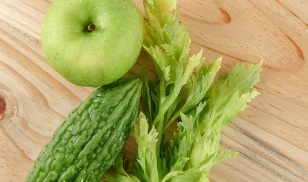
Gout is a disease associated with poor exchange of purine bases. It leads to the deposition of uric acid salts in the joints and internal organs.
The main symptom is recurrent attacks of acute arthritis, the formation of tofus (foci of compaction) on the legs and earlobes. Therapy in the active period is medication, with the use of anti-inflammatory drugs.
To speed up the onset of remission and increase its duration, the patient is advised to adhere to certain principles of nutritional therapy. A proper diet for gout can significantly improve the quality of life of the patient, reduce the number of attacks of the disease, reduce the risk of irreversible damage to the kidneys, the central nervous system and the musculoskeletal system.
Goals and Principles of Diet Correction
The main objective of dietary nutrition in gout patients is to reduce the concentration of uric acid complexes in the blood plasma. The products that the patient consumes should be selected so that none of them contain more than 150 mg of purines per 100 g of weight. The patient is shown in table 6.
The diet is more effective if the following principles are followed:
- Strict compliance with the rules until irreversible changes occur. It is impossible to remove the conglomerates already formed in the joints and kidneys by gastronomic restrictions. The selected menu has a preventive purpose, it helps to prevent the deposition of salt.
- The dietary approach, taking into account the frequency of seizures, the level of uric acid, the severity of the process. Outside of exacerbation, the diet should contain a reduced amount of protein, fat, and sodium salts. Alcohol must be completely removed. In the active period, strict restrictions are shown: food is scarce, mainly liquid.
- Weight correction. For obese people, products are selected so that the total calorie content is below the level of energy consumption by 300-500 kcal per day. The patient's lifestyle and level of daily physical activity should be considered.
- No more than 200 mg of purine bases per day. The indicated figure is essential for the patient. A large amount of uric acid compounds does not allow to keep their level in the body within acceptable limits.
In addition to the above, compliance with the drinking regime is required. If there are no contraindications of the cardiovascular system, the patient should consume about 2 to 2. 5 liters of fluid per day. Hydrocarbonate mineral waters are recommended. This promotes alkalization of the internal environment, reducing acidity.
Nutrition during exacerbation
At the stage of increased uric acid content in the blood and recurrence of the pathology, dietary restrictions are more significant. The total daily amount of protein should be kept within 70 g, fat - 80 g, carbohydrates - 240 g. The caloric content of the diet is 1950-2000 kcal. Diet: four times a day, in between, you need to drink liquid. Food temperature is normal, 55–60 ° C for hot dishes and 15 ° C for cold dishes. No specific thermal saving is necessary. It is best if the consistency of the food is liquid or soft.
The following foods are recommended:

- milk;
- lactic acid drinks;
- vegetable juices;
- citrus-based juices;
- liquid cereals;
- grated fruits;
- fish caviar;
- tomato sauce.
In the presence of clinical manifestations of the disease, a person should not eat foods that are acceptable in the remission stage. It is necessary to refuse solid dishes, cakes, meat and fish in any form, eggs, sweets, spices, oils. The requirement for animal protein is satisfied exclusively with dairy substances. Restrictions must be observed during the duration of the attack. On average, this takes 5 to 7 days. After the inflammatory process in the legs subsides, they gradually return to the usual diet. The crossing takes 2 to 3 days.
Nutrition in remission
Compliance with a diet for gout is necessary even in the absence of severe symptoms. The restrictions in this case are not as severe as during exacerbations. However, they must be strictly adhered to. A fundamental requirement is the complete elimination of meat from young animals, which contains the maximum amount of purines. Its concentration can reach 1000 mg per 100 g, which is many times higher than the allowed values. Also, extracts of meat, mackerel, sardines, the interior of cattle (liver, kidneys, brain), alcoholic beverages are categorically contraindicated.
Table number 6 implies the use of 100 g of protein and fat, 450 g of carbohydrates per day. The total nutritional value of the daily menu is 3200 kcal. The volume of fluid is 1. 5-2 liters, if this does not contradict the treatment of other diseases that a person has.
The list of what a patient can do includes:
- kefir;
- fresh cabbage cabbage soup;
- buckwheat porridge;
- tortilla;
- rye bread;
- fruit jam;
- vegetable oil;
- lemon or orange;
- mashed potatoes;
- fish souffle;
- cereals;
- eggs;
- cheese;
- dietary meat in an amount not exceeding 120 g per day.
The purine base level is lower in products such as cereals, vegetables, honey, nuts, and tomatoes. They can be eaten with practically no restrictions. Pork fat, beans, spinach, sorrel and mushrooms contain 50-150 mg of the substance, which should be taken into account when compiling the menu.
To lose weight
Weight loss is recommended for patients with hypersthenic and normostenic physique. The caloric content of the diet should be reduced to 30 calories per kilogram of weight. It is important that the weight loss occurs gradually, no more than one kilogram per month. This will ensure an acceptable level of ketone formation. With a pronounced lack of nutritional value of products, their synthesis exceeds the permissible limits. A low calorie diet excludes or significantly limits the consumption of baked goods.
Prohibited foods: bread, cakes, pizza, cakes, cheesecakes, cakes, sugar, sweets, sweet jam, preserves, etc.
The table must be based on the components:
- low-fat cottage cheese;
- kefir;
- vegetables;
- fruits.
Weight management is not limited to low calorie meals. The patient must lead an active lifestyle, participate in physical education according to an individually developed program. Otherwise, the dietary restrictions will be too strict, reducing a person's adherence to therapy.
Sample menu for one week
Gout patients need to know exactly what is not and what is acceptable to eat. It is best if a person clearly describes their diet over a relatively long period of time. Meals are generally developed over a week. The existing scheme can be used for several months, after which the set of dishes is completely changed or shaken every day. With a high uric acid level, the weekly diet can look like this /.
Monday
- Breakfast # 1: casserole, coffee with milk.
- Breakfast # 2: baked apple.
- Lunch: vegetable soup, bread, rosehip broth.
- Afternoon snack: fruit jelly.
- Dinner: cabbage rolls, kefir.
Tuesday
- Breakfast n. 1: cheese, tea, bread.
- Breakfast # 2: orange.
- Lunch: lean cabbage soup, bread, herbs.
- Afternoon snack: buckwheat porridge.
- Dinner: kefir, carrot puree.
Wednesday
- Breakfast n. 1: egg, fruit juice.
- Breakfast # 2: jam, mineral water.
- Lunch: vegetable borsch, rye bread, tea.
- Afternoon snack: milk jelly.
- Dinner: nuts, jam.
Thursday
- Breakfast # 1: cucumber salad, rose hips.
- Breakfast # 2: orange pomace.
- Lunch: potato soup, fruit drink.
- Afternoon snack: pear.
- Dinner: scrambled eggs, dried apricots, tea with lemon.
Friday
- Breakfast n. 1: boiled beets, cranberry juice.
- Breakfast # 2: kefir.
- Lunch: pearl barley soup, tea.
- Afternoon snack: milk, bread.
- Dinner: carrot cutlets.
Saturday
- Breakfast n. 1: rice porridge, coffee.
- Breakfast # 2: watermelon.
- Lunch: soup, milk jelly.
- Afternoon snack: fresh cucumber.
- Dinner: kefir, bread.
Sunday

- Breakfast n. # 1: soft-boiled egg with sour cream and tea.
- Breakfast # 2: grapes.
- Lunch: cabbage chops, barley soup, juice.
- Afternoon snack: casserole.
- Dinner: pancakes, yogurt.
The diet given is not complete. Any component from the list of what is allowed for the patient can be added to it.
Care must be taken to ensure that the total caloric content of foods and the content of purine bases in them do not exceed the established limits.
Cooking methods
Dishes can be steamed or baked. This approach allows you to ensure the optimal taste of the product, while maintaining its useful properties. Foods processed in this way assume a mild regimen for patients with concomitant diagnoses of a gastroenterological profile. Cooking is allowed, however if meat or fish are cooked this way the broth will drain. The fact is that during processing, about 50% of the purines contained in animal muscle fibers are transferred to it.
Proper nutrition is one of the main components of treatment for gout in the legs. A person who does not meet the necessary conditions for the development of a diet is much more likely to suffer relapses of the disease, even with a properly selected drug therapy. Refusal of proper nutrition during an exacerbation contributes to increased symptoms and increased time for recovery. The patient receives detailed information on what not to eat and what not to eat from his treating physician. Therefore, at the first signs of pathology, you should seek the help of a specialized specialist who will competently select a diet and prescribe treatment.




























